Adventurous Hike in the Qinngua Valley
Enjoying the Arctic nature and the pristine wilderness of Greenland is a dream come true for any hiker. But it can also be extremely tough and sometimes risky. This is certainly the case when the hike at Nanortalik in South Greenland takes you over difficult boulders and steep mountainsides, through bottomless swamps and across rushing rivers.
- Published: November 3, 2022
At the end of August 2022, I embarked on a solo hike from the village of Tasiusaq in South Greenland to the iconic Paradise Valley – or Qinngua Valley as it is called in Greenlandic.
Qinngua Valley is known for having Greenland’s only ‘real’ forest thanks to a relatively warm and sheltered climate far from the sea. There are massive granite mountains and many glaciers on both sides of the long and narrow valley. The valley is supposed to be absolutely beautiful, and I’m really looking forward to the hike there.
I have filled my backpack with enough food for at least 7 days, as well as my lightweight tent, trangia cooking set, clothes, and various equipment. I don’t have time to weigh the backpack, but it’s pretty heavy, and on the wrong side of 20 kg, I think.
DAY 1
I spent the night at the Kap Farvel hotel in Nanortalik and then went sailing on Disko Line’s scheduled boat to Tasiusaq. Departure at 10.25 am and after sailing all the way past two other settlements, I arrive in Tasiusaq at around 2.30 pm.
From the harbour in Tasiusaq, I head east past the heliport and then follow a gravel road in a north-easterly direction along the coast of the smaller Tasiusaq Fjord. It’s raining, so it’s not the best start.
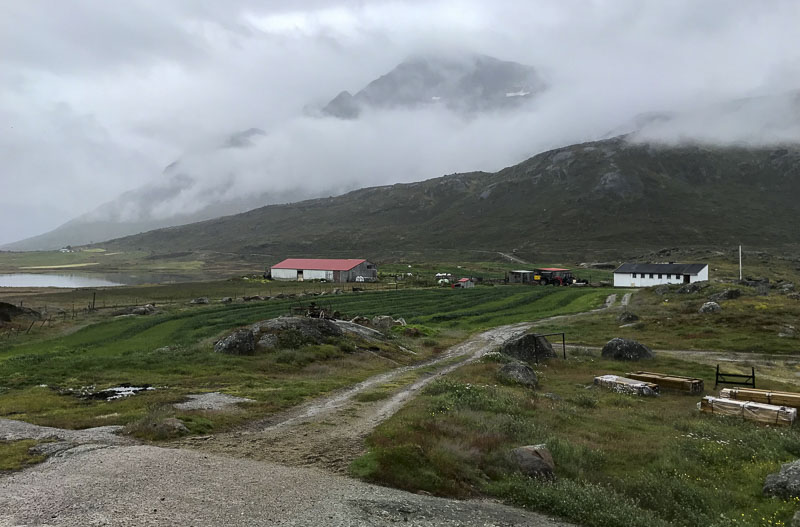
There is also a trail all the way down the coast, but due to the rain I opt for the gravel road. After 4 kilometres I reach the sheep farm Saputit, where I visit the local farmer for a cup of coffee.
From here I follow the gravel road to the east and another 4 km to the northeast until I reach the southern tip of the large lake, Tasersuaq. Here, there is a sandy beach and good campsites.
There are a couple of boats belonging to the sheep farmers of Saputit. I meet a group of 6 people from Switzerland and pitch my tent near them. It has been raining most of the day, but luckily it’s dry right now.
DAY 2
Fog and clouds lift during the morning and the sun peeks out, so it looks like it’s going to be a lovely day. After breakfast, I set off with the group from Switzerland. We walk along the eastern shore of the southern tip of Tasersuaq. Then we walk overland about 3 km to the NE until we reach a small pebble beach.
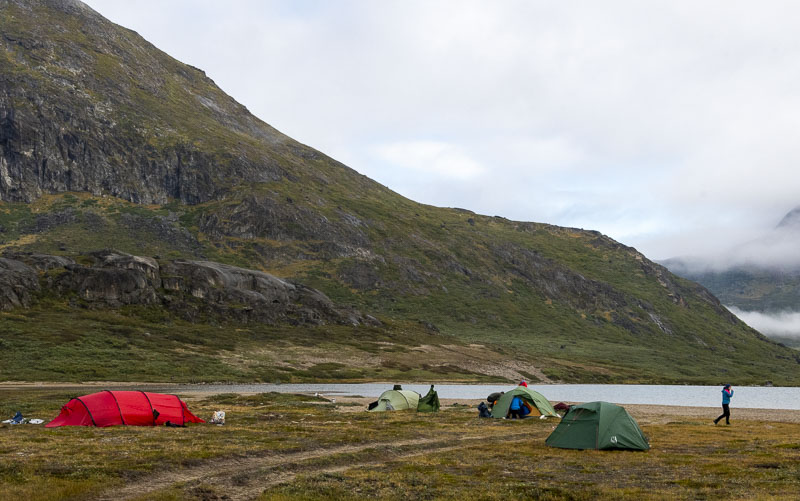
After a ‘see you later’ with the Swiss, I continue alone along the south shore of Tasersuaq. Now the more difficult terrain begins. I walk close to the lake. In some places there is dense birch scrub (2-3 metres tall Mountain Birch), but it can be more or less traversed via sheep tracks. In other places, it’s easier to jump from rock to rock in the lake.
After about 4 kilometres, I reach the bottom of a small inlet in the lake, where there is a cairn and a couple of good tentsites. From here, I have to decide whether I want to follow the headland (cape) along the lake shore or go up over the mountain ridge. In 2019, I walked around the headland, which was difficult, but manageable.
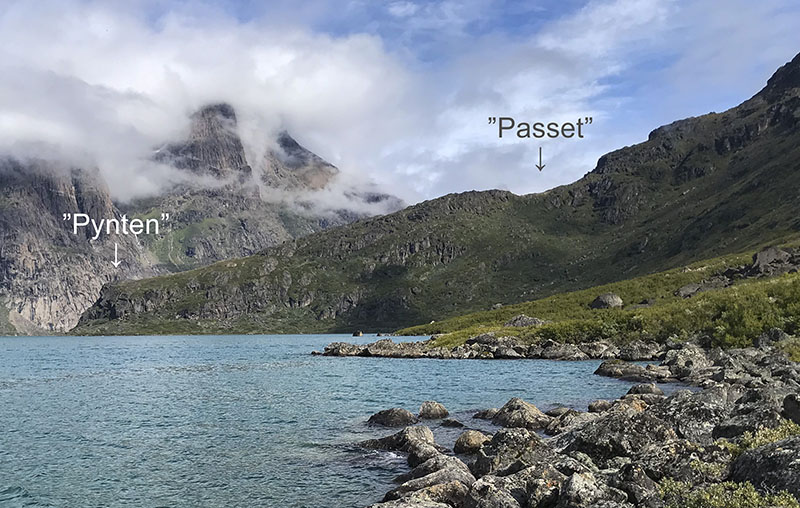
This time I choose to cross the mountain ridge via a pass that is at an altitude of about 300 metres (see photo above). However, I should never have done that!
The walk up is really difficult and strenuous, especially with a heavy backpack. The ascent is steep and the mountainside is covered in tall and nearly impassable birch and willow scrub. Boulder fields and in places vertical passages make the ascent even more difficult.
I lose my sense of direction on the way up and can’t find the pass, and at the same time I’m running out of time before it gets dark. Finally, I have to give up and descend the mountainside back towards the starting point at the lake.
Suddenly, I fall two metres when I lose my footing on a rock ledge for a split second. I land on my back. Completely sprawled out and stunned. I see the starry sky above me and can feel the rocky ground and shrubbery. All I hear is the trickle of a spring and my own breathing. I am unharmed. The backpack broke the fall. I’m trying to get up and then stumble further down the ridge.
The darkness of night has long since fallen. I’m completely alone and the first witness to a pitch-black polar sky where the stars and the Milky Way are razor-sharp. The moon hides behind a mountain and spectacular Northern Lights stretch in white and light purple across the large lake.
And in the middle of this beautiful setting, I’m cursing myself for leaving my headlamp at home. Fortunately, I have my hiking poles, which now prove invaluable in my blind quest down the mountain through rock, boulder field and man-sized birch scrub.
It’s past midnight before I reach the lake shore, totally exhausted after many hours of futile trial of strength with the 300 metre high mountainside. I quickly set up the tent and devour large amounts of food. I’m too tired to light the trangia, so the menu is raw sausages, salted nuts and rye bread. But oh, it tastes so good.
Day 2 of my hike is over. It was a rough experience. Fortunately, the rest of the hike will turn out to be truly amazing.
DAY 3
The next morning I choose – wisely – the route around the headland! After just under 1 km along the lakeshore, I head away from the shore upwards to a height of 20-30 metres above the lake. Here there are a couple of difficult passages on sloping terrain and through scrub, where a bit of climbing is necessary.
The rest of the way around the headland is somewhat easier, where I can mostly follow sheep tracks that run just below the vertical rock wall at about 20-50 metres above the lake. One shouldn’t go all the way down to the lakeshore (too dangerous with difficult climbing passages). Occasionally the sheep tracks disappear into willow scrub, but quickly reappear.
After rounding the headland, I head back down towards the lakeshore. I then walk about 3 km in a south-easterly direction in easy terrain along the lake on gravel and pebble beaches, across boulders and some scrub. A couple of rivers are waded by jumping from stone to stone before I reach the large river, Qingeq Kujalleq.
I wade across the river at its mouth, where there are some sandbanks. However, it is also somewhat deep, as the water reaches my waist at the deepest point. But I manage to cross safely. However, the best place to cross the river is about 200 metres from the lake (I find out later), where there are some large rocks in the river. A trodden, partially overgrown path leads to this ford. The water here reaches thigh or hip height, depending on how much snow has melted in recent days.
On both sides of the river there are good tenting opportunities. After crossing the river, I walk on relatively easy terrain for half an hour along a sandy beach and through some scrub/blocks until I reach the start of the Qinngua Valley. Here are good tentsites on an elongated river bed on the east side of the Qinngua River.
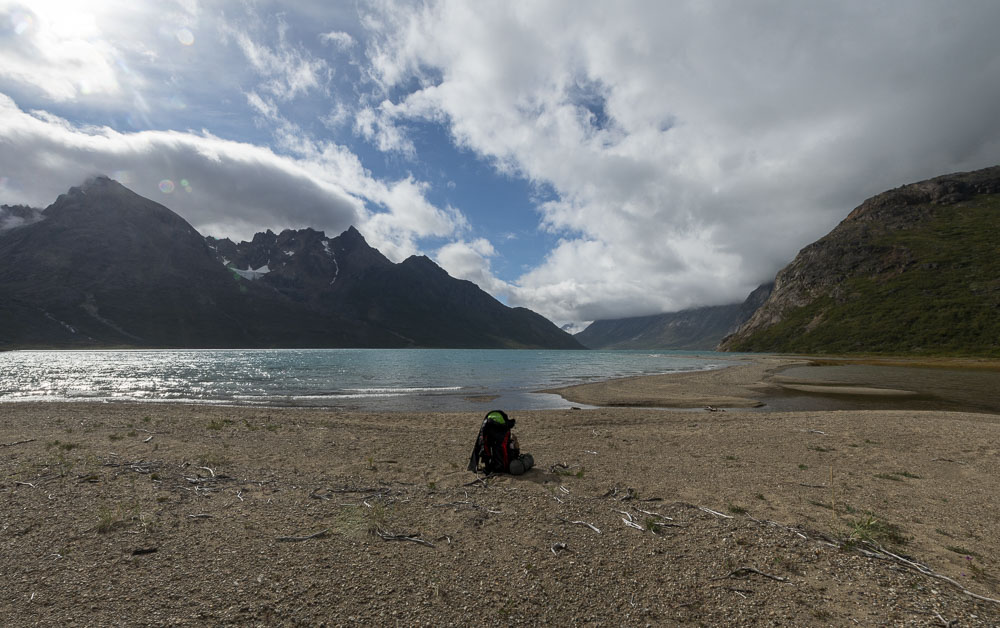
The Qinngua River is a large, rushing river that is difficult to cross, so I refrain from doing so. The water is at least waist deep. Further up the valley, it’s easier to ford, but I stay on the east side of the river.
I walk about 500 m along the river until the birch forest truly begins. This is where you can experience Greenland’s only ‘real’ forest, where trees of the species Mountain Birch reach up to 8-10 metres in height. I also see tall bushes/trees of Greenland Mountain-ash and Gray Willow.
I follow a sheep track close to the river (be careful not to fall in) for 3-400 metres through tall birch scrub. Difficult to get through with a backpack. Then I reach a new river bed that looks like a good tentsite, where there is also a campfire site.
A new sheep track is followed through more of the dense birch forest. After about 500 m to the NE, it opens up again and I walk about 2 km on relatively open terrain that is slightly ascending and with low scrub.
I struggle a few more kilometres into the valley and pitch my tent on a suitable riverbank. The eternal rush of the raging river is sweet music to my ears and I sleep like a log that night.
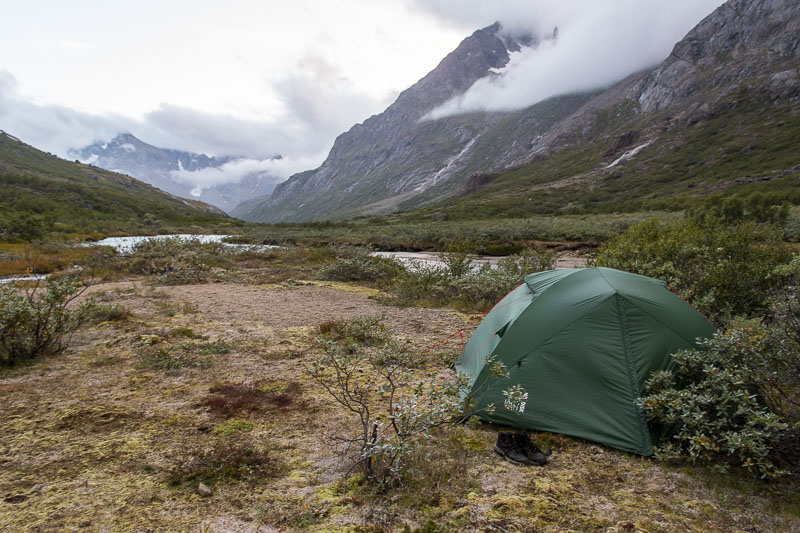
DAY 4
I’m ready to move on and today even more troublesome birch scrub awaits, complemented by challenging boulder fields. In general, I recommend to walk close to the Qinngua River, where in some places there are flat stretches with gravel deposits and low vegetation.
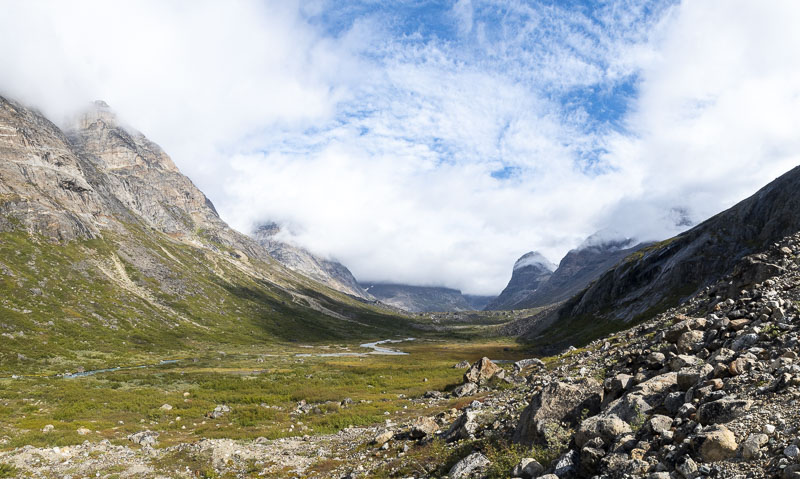
After a few hours, the first glacier on the east side comes into view. Its front is high up (approx. 500 m above sea level), while the rocks below are completely worn smooth by the erosion of the ice. The same goes for the next two glaciers on the east side that I pass. They are very impressive. But it’s also worth a thought that the fronts have retreated so much, which is probably due to global climate change.
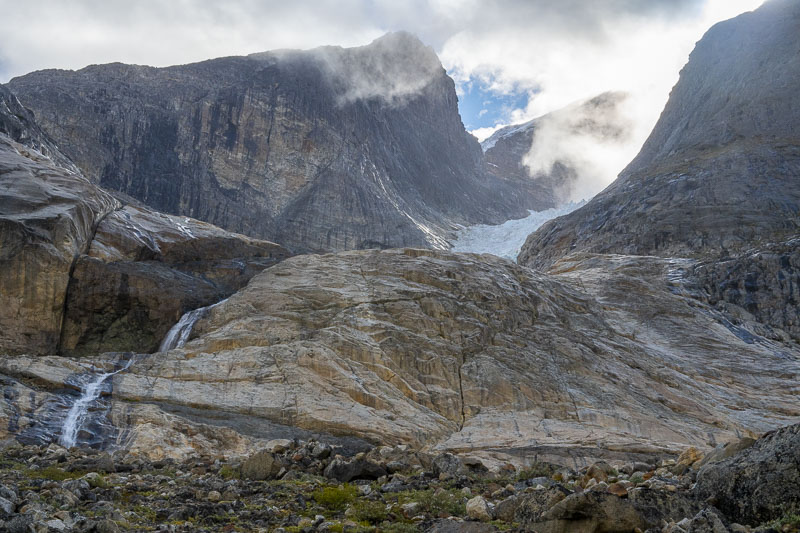
Smaller rivers from the glaciers must be crossed either by wading to knee height or jumping from rock to rock.
I then come to an area of rough boulder field. Close to the Qinngua River there is impassable birch scrub, but further east it looks like I can follow the boulder field up – a climb of about 50 altitude metres – by following the west side of a smaller glacial river.
I then reach a larger plateau with low vegetation and quirky boulders scattered around the valley landscape. It’s incredibly beautiful here, with high granite mountains and many glaciers on both sides of the valley. The sun is shining and it’s just heavenly. Getting here is worth all the effort. I’ve simply never seen anything so beautiful before!
I stroll euphorically through this amazing landscape and find a suitable spot to pitch my tent not far from a large glacial lake. Apart from a White-tailed Eagle that flew overhead a few moments ago, I’m completely alone in this desolate wilderness. I haven’t even seen an Arctic Fox or Arctic Hare – the only land mammals common in the area.
The tentsite is located about 200 m south of a large, turquoise blue glacial lake (230 m above sea level) with excellent drinking water. You won’t see the lake directly due to tall rocks, but it can be reached by a slightly winding passage past some boulders.
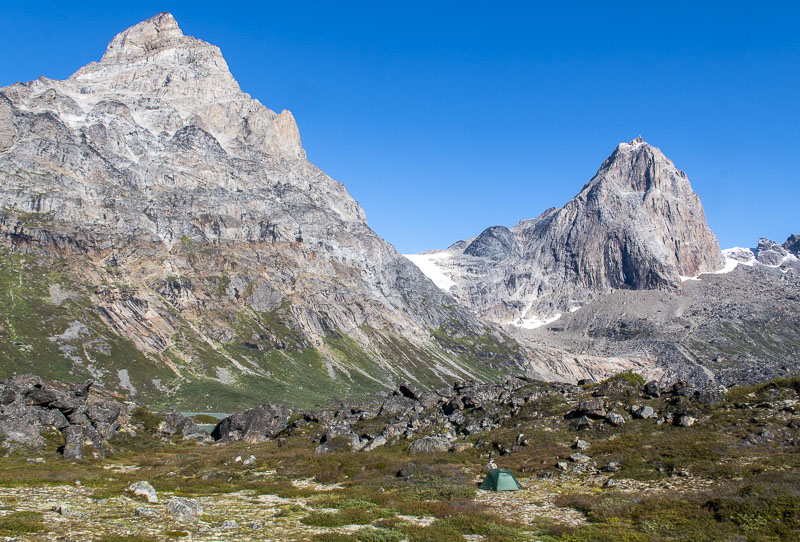
DAY 5
I have a few days to explore the Qinngua Valley further before I have to return along the same route I came. At the end of the valley, there is a pass at an altitude of about 600 metres that must be crossed before descending through a new glacial valley to reach the bottom of Kangikitsoq Fjord.
I leave the tent and rejoice that I only have a very light backpack with me today. I walk for an hour or so to the north-east in low vegetation. There are incredibly beautiful views on all sides. Majestic granite mountains, high glaciers, and below a delta with winding rivers that end in the turquoise lake. The valley certainly lives up to its English/Danish name, Paradise Valley.
I’m blessed to see one of the glaciers calving. That is, I hear a loud thunderous noise and as I turn towards the sound, I realise the calving is nearly at its end. It’s a huge amount of ice falling from the upper part of the glacier to a plateau below. I see it happen three times. The first time I get a huge shock from the loud crash.
I reach the start of a large boulder field area that I have to pass through. For those who like to jump from rock to rock and boulder to boulder, this pass is like a giant playground. Here, the glaciers have created oversized rock piles, so-called end moraines. And boulders are scattered everywhere from millions of years of erosion of the mountain massifs.
In the middle of it all, I discover a small river, which I follow further up. It splits and joins several times with many small and large waterfalls. It’s like a green stripe in the rocky landscape with an incredible lushness of grasses, the large Angelica, Arctic flowers, and pale green mosses. Truly beautiful and fairytale-like.
At the top of the pass is a small lake at 555 m above sea level. About 500 m before the lake, the small river disappears under the rocks. The last stretch towards the lake is characterised by large boulders. The Lake 555 is best passed to the west, as the slopes are too steep on the east side.
After some searching, I find a suitable place to climb up to about 40-50 m above the lake, after which I can walk past it. I reach a really beautiful viewpoint at an altitude of about 600 m. To the south-west is a large glacier with abraded rocks and a green valley below, to the south-east another glacier and further east I can see the Kangikitsoq Fjord.
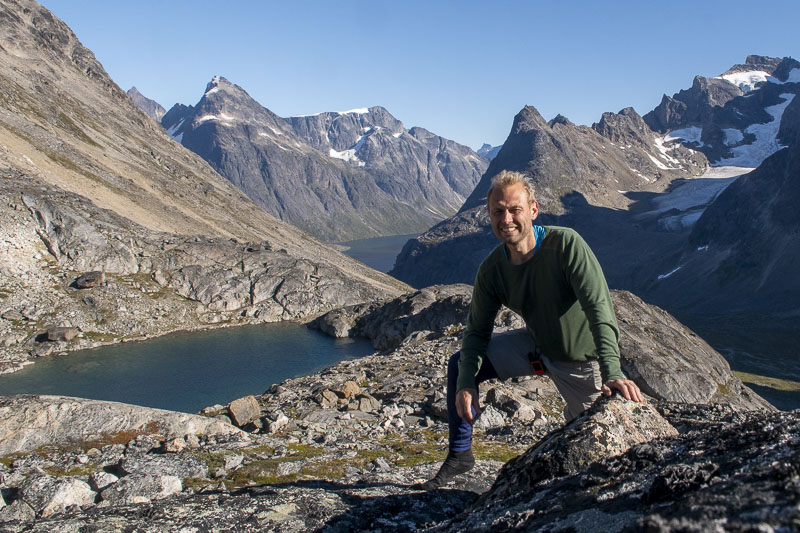
DAY 6
My days in Paradise (Qinngua Valley) have given me many experiences for a lifetime. Now it’s time to head back towards Tasersuaq Lake. There, I have an arrangement with Malik, a local sheep farmer, to pick me up by boat, saving me a day and a half’s walk to the village of Tasiusaq, which is also where I started my adventure.
The return journey through Qinngua Valley feels much easier than the outward journey. I’ve already been there so I recall many details and the terrain slopes slightly downwards, so I have a better view and can try to avoid the worst of the birch forest.
I pitch my tent on the shore of Tasersuaq Lake. The sun sets behind a distant mountain and a large White-tailed Eagle fights three Ravens for aerial domination.
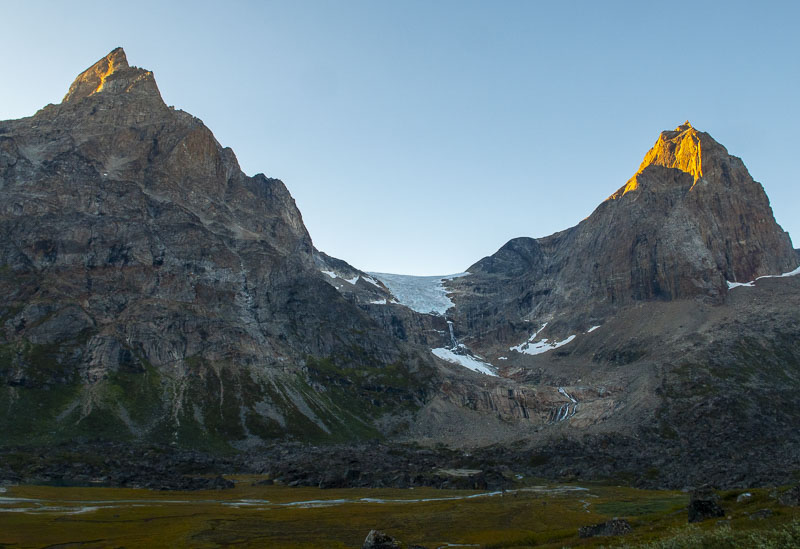
DAY 7
This morning it’s completely calm, but in a short time the wind is blowing strongly from the east. Suddenly there are big waves on the lake, and after a few hours of waiting, I get a GPS message that the boat can’t make it.
I have to walk, and it’s not until I reach the behated mountain headland from day 2 that I see Malik’s small dinghy struggling against the waves.
From a shore, I get on board and it’s a boat trip back to Tasiusaq, where Malik literally has to ride the waves. A final testimony to the great forces at work in Greenland’s wild nature. And how peace and idyll can quickly turn into troubled waters and danger.
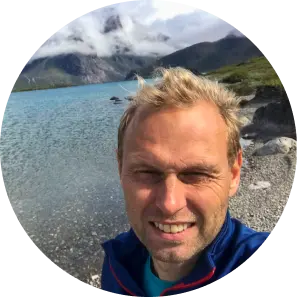
About the hike
Distance round trip: 90 km
Duration: 7 days
Highest point: approx. 600 m
Lowest point: 0 m
Difficulty: Hard
This hike goes from the village of Tasiusaq to Qinngua (Paradise Valley) and up through the valley and back again along the same route.
The hike is in difficult mountain terrain. The route is not marked, but there are occasional footpaths or sheep tracks.
Reaching Qinngua Valley is for experienced hikers who have experience with remote and difficult mountain terrain. It is possible to shorten the trip by being transported across Lake Tasersuaq in one of the sheep farmers’ small dinghies. This can be arranged with the tourist office in Nanortalik.
Map
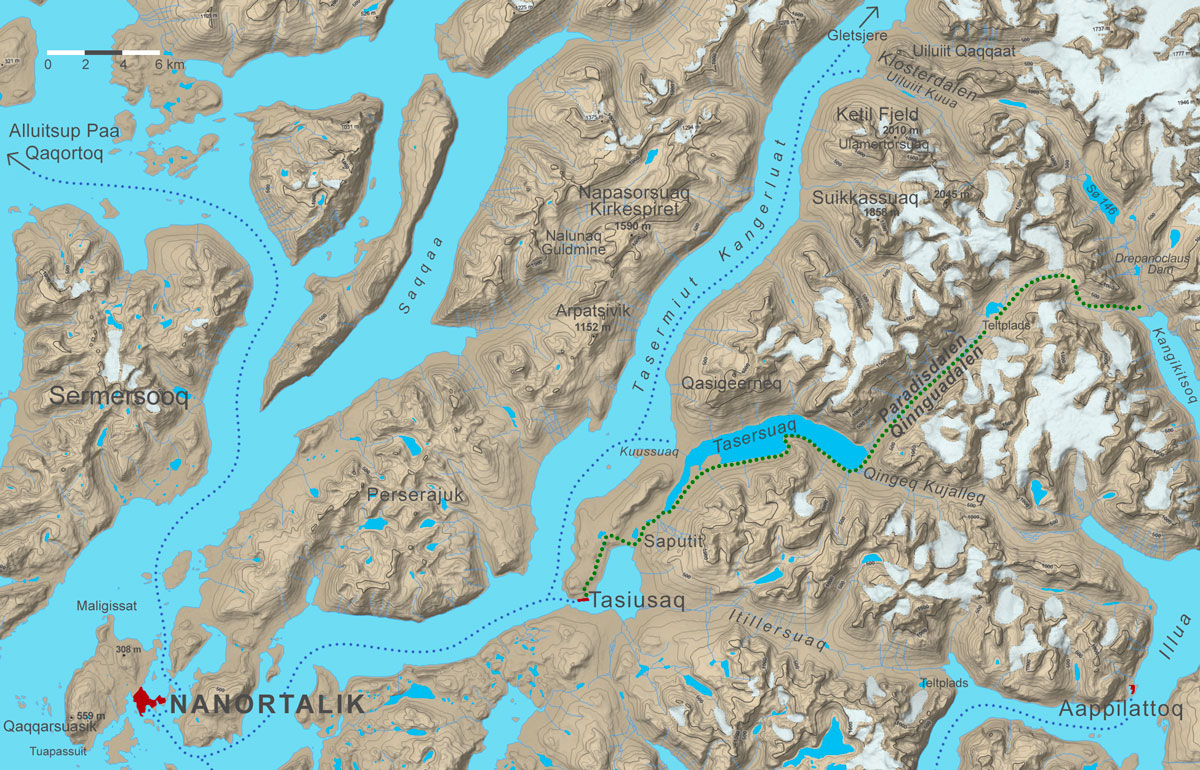
The Qinngua Valley is a narrow, 15 km long valley framed by 2,000 metre high mountains and many glaciers on both sides. It is lush and green, and scientists have found more than 300 plant species here.
Qinngua Valley is a protected site and the pristine nature must not be disturbed or damaged in any way.
Qinngua Valley is very remote. The nearest habitation is the small settlement of Tasiusaq, at least a two-day hike away.
The few families living in Tasiusaq live primarily from fishing and sheep farming, and the settlement itself is an isolated place deep in Tasermiut Fjord. To get to Tasiusaq, you need to sail from Nanortalik, Greenland’s southernmost town. Disko Line sails every Friday.
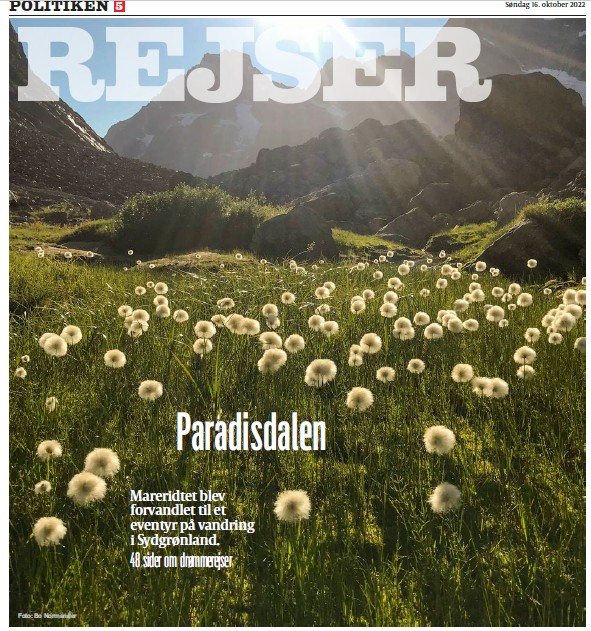
For Danish readers: my travelogue from Qinngua Valley (‘Paradisdalen’) in the Politiken newspaper online version (free guest access).
My trip to South Greenland was supported by Visit Greenland, Blue Ice Explorer, and Disko Line.